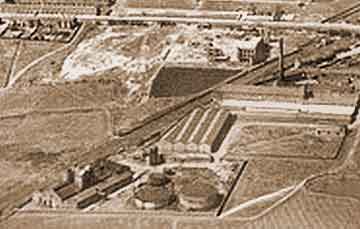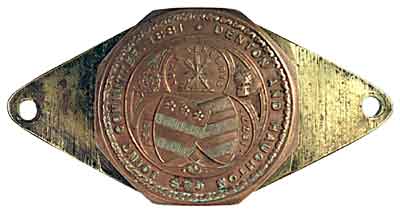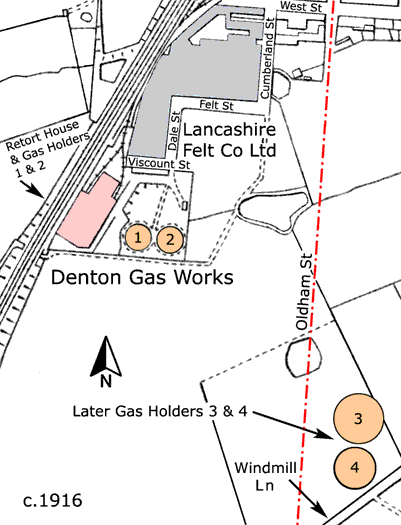Viscount St, Denton
The origin of Denton Gas Works dates from 1854 when the Dukinfield Gas Company was formed and subsequently the Dukinfield and Denton Local Boards Act of 1877
allowed this gas works to be absorbed and managed by the new Local Boards. This gas works was based on Blandford St at Ashton-under-Lyne and from 1877 it was managed by a Joint Committee of the Boards
incorporated as the Dukinfield and Denton Joint Gas Committee. Besides supplying gas to Dukinfield and Denton the Joint Gas Committee also supplied gas to the township of Haughton but
this committee was dissolved when a new gas works was built at Denton.

Denton Gas Works, 1935.
In Nov 1879 the Dukinfield and Denton Joint Gas Committee was dissolved and replaced by the Denton and Haughton Gas Joint Committee. In 1880 the Denton and Haughton (Gas) Act permitted these townships to have a separate gas works and in same year the Denton and Haughton Gas Joint Committee compulsorily purchased land from the Earl of Wilton.

Copper alloy cap.
The lettering around the circumference of the cap reads: DENTON AND HAUGHTON GAS JOINT COMMITTEE, 1881. The Latin motto around the three crossed arrows reads: LUX E TENEBRIS, ‘Light out of Darkness’. The three crossed arrows mean moving forward together. The Denton shield, left, is dated 1857 and the Haughton shield, right, is dated 1877. Denton adopted the Public Health Act of 1848 in 1857 and Haughton adopted it in 1877.
The land chosen for the gas works was situated off the south side of Manchester Rd and on the east side of the London & North Western Railway (Stockport & Guide Bridge Line). A siding was constructed from the railway for the supply of coal to the retort house. The new gas works opened in 1884 at a cost of £37,774. Meanwhile, Dukinfield Local Board continued to operate but eventually the gas works based on Blandford St was closed and a new one was opened at Dukinfield. This was situated off the west side of Charles St adjoining Plantation Farm. In 1938 the Hyde Gas Company purchased both the Dukinfield and Denton gas undertakings. Hyde Gas Works was on Raglan St. Following the passing of the Gas Act in 1948 all the gas making and supply undertakings were nationalised and this became effective on the 1 May 1949 (vesting day). This Act established 12 area gas boards under a central authority; the Gas Council. Henceforth, all the gas works in North West England came under the control of the North Western Gas Board.

Commencing in 1968 the natural gas (methane) conversion process started throughout Britain and the work was completed in 1976. In 1986 the gas industry was privatised, creating British Gas plc and in 1997 this company was split into Centrica plc and the BG plc/BG Group plc.
Originally, two gas holders (aka gasometers) were provided at Denton Gas Works but these were superseded by two larger gas holders built in 1954 and 1963, respectively. These were situated to the east of Oldham St and further to the south. By January 2019 work was underway in dismantling the two gas holders on Oldham St as they were no longer required.
Town gas (aka coal gas) was made by heating coal in the absence of air in a retort and by doing this the gas was released without undergoing combustion because there was no oxygen present. The residue was known as coke and this was used as a fuel in furnace retorts* and/or it was sold as a smokeless fuel. Raw gas flowing from the retort was first passed through a condenser to remove bitumen, which is a black viscous liquid related to creosote that is generally referred to as ‘tar’. Next, it passed through a purifier and after cleaning (known as ‘scrubbing’) it was ready to be distributed to users, either directly or via a gas holder. Town gas was mainly comprised of carbon monoxide, hydrogen and methane but when it left the condenser it still contained impurities such as toxic hydrogen sulphide, ammonia and hydrocarbons, particularly benzine, which is highly flammable.
Gas Holders vs Gasometers
There is a historic reason for gas holders sometimes being called gasometers. The first gas holders consisted of a large hollow piston floating on water.
Calibration marks on the piston showed how much gas was being made or used as it rose and fell, so these devices became known as gasometers.
Further Reading
Middleton, Thomas, 1936. History of Denton and Haughton. Hamnett St, Hyde: J Andrew & Co Ltd.
National Gas Archive, Warrington.
